
 China Tours
China Tours Tibet Tours
Tibet Tours China Theme Tours
China Theme Tours Off The Beaten Track
Off The Beaten Track Yangtze Cruises
Yangtze Cruises China Trip Planner
China Trip Planner Travel Agents
Travel Agents


We had a wonderful time in Tibet. We have learned a lot about this unique destination because of the wonderful guide Degyi who is so knowledge and always available towards our tours. We stayed at the Shangri-La Hotel Lhasa, and we would never imagine a Tibet travel could be so nice and amazing without the help of Degyi.
Also, thanks a lot to our Tibetan driver Mr.Wongdun for his safe driving and a good sense of service along the way.
We shall return Tibet in the near future!
P.B. and A. A - Europe
Tibet Travel
June 2018 (Private Tibet Journey from Kathmandu)

 China is a united multi-ethnic nation of 56 ethnic groups. As the majority (91.6 percent) of the population is of the Han ethnic group, China's other 55 ethnic groups are customarily referred to as ethnic minorities. According to the fifth national census in 2000, 18 ethnic minorities have a population of over one million, namely the Zhuang, Manchu, Hui, Miao, Uygur, Yi, Tujia, Tibetan, Mongolian, Bouyei, Dong, Yao, Korean, Bai, Hani, Li, Kazak and Dai. Of these the Zhuang ethnic group has the biggest population, numbering 16.179 million. There are 17 ethnic groups with a population of between 100,000 and one million, namely the She, Lisu, Gelao, Lahu, Dongxiang, Va, Sui, Naxi, Qiang, Tu, Xibe, Mulam, Kirgiz, Daur, Jingpo, Salar and Maonan. There are 20 ethnic groups with a population of between 10,000 and 100,000, namely, Blang, Tajik, Primi, Achang, Nu, Ewenki, Gin, Jino, Deang, Ozbek, Russian, Bonan, Monba, Oroqen, Derung, Tatar, Hezhen, Gaoshan (excluding the Gaoshan ethnic group in Taiwan) and Lhoba. The Lhoba ethnic group, at 2,965, has the smallest population.
China is a united multi-ethnic nation of 56 ethnic groups. As the majority (91.6 percent) of the population is of the Han ethnic group, China's other 55 ethnic groups are customarily referred to as ethnic minorities. According to the fifth national census in 2000, 18 ethnic minorities have a population of over one million, namely the Zhuang, Manchu, Hui, Miao, Uygur, Yi, Tujia, Tibetan, Mongolian, Bouyei, Dong, Yao, Korean, Bai, Hani, Li, Kazak and Dai. Of these the Zhuang ethnic group has the biggest population, numbering 16.179 million. There are 17 ethnic groups with a population of between 100,000 and one million, namely the She, Lisu, Gelao, Lahu, Dongxiang, Va, Sui, Naxi, Qiang, Tu, Xibe, Mulam, Kirgiz, Daur, Jingpo, Salar and Maonan. There are 20 ethnic groups with a population of between 10,000 and 100,000, namely, Blang, Tajik, Primi, Achang, Nu, Ewenki, Gin, Jino, Deang, Ozbek, Russian, Bonan, Monba, Oroqen, Derung, Tatar, Hezhen, Gaoshan (excluding the Gaoshan ethnic group in Taiwan) and Lhoba. The Lhoba ethnic group, at 2,965, has the smallest population.The Han people can be found throughout the country, mainly on the middle and lower reaches of the Yellow River, the Yangtze River and the Pearl River valleys, and the Northeast Plain. The 55 ethnic minorities, though fewer in number, are also scattered over vast areas and can be found in approximately 64.3 percent of China, mainly distributed in the border areas of northeast, north, northwest and southwest China. Yunnan Province, home to more than 20 ethnic groups, has the greatest diversity of ethnic groups in China. 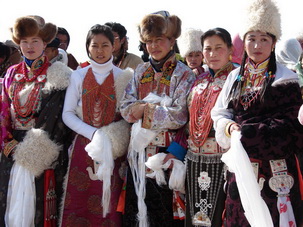
Tibetan Ethnic Minority
The Tibetans with a population of 5.4 million mostly live in the Tibet Autonomous Region. There are also Tibetan communities in Qinghai, Gansu, Sichuan and Yunnan provinces.
Tibetan Language & dialects
The Tibetan language belongs to the Tibetan sub-branch of the Tibetan-Myanmese language branch of the Chinese-Tibetan language family. According to geographical divisions, it has three major local dialects: Weizang, Kang and Amdo. The Tibetan script, an alphabetic system of writing, was created in the early 7th century. With four vowels and 30 consonants, it is used in all areas inhabited by Tibetans.
Tibetan History
The Tibetans first settled along the middle reaches of the Yaluzangbu River in Tibet. At the beginning of the 7th century, King Songzan Gambo began to rule the whole of Tibet and made "Losha" (today's Lhasa) the capital. He designated official posts, defined military and administrative areas, created the Tibetan script, formulated laws and unified weights and measures, thus establishing the slavery kingdom known as "Bo", which was called "Tubo" in Chinese historical documents.
After the Tubo regime was established, the Tibetans increased their political, economic and cultural exchanges with the Han and other ethnic minorities in China. In 641, King Songzan Gambo married Princess Wen Cheng of the Tang Dynasty (618-907). In 710, King Chide Zuzain married another Tang princess, Jin Cheng. The two princesses brought with them the culture and advanced production techniques of Central China to Tibet. From that time on, emissaries traveled frequently between the Tang territory and Tibet. The Tibetans sent students to Chang'an, capital of the Tang Dynasty, and invited Tang scholars and craftsmen to Tibet. These exchanges helped promote relations between the Tibetans and other ethnic groups in China and stimulated social development in Tibet.
From the 10th to 12th century, Tibet fell apart into several independent regimes. The Yuan Dynasty (1279-1368) founded by the Mongols in the 13th century brought the divided Tibet under the unified rule of the central government. During the Qing Dynasty (1644-1911), the emperor conferred the titles of the "Dalai Lama" (1653) and "Bainqen Erdini" (1713) on two living Buddhas of the Gelugba sect of Lamaism. The Qing court began to appoint a high resident commissioner to help with local administration in 1728, and set up the Kasha as the local government in 1751. In 1934 the Government of the Republic of China set up a resident agency to administer affairs in Tibet, and in 1965, Tibet Autonomous Region was established.
Tibetan Agriculture
The Tibetans are engaged in stockbreeding and agriculture, with highland barley as the main crop and sheep, goat and yak as the main livestock. Yaks are known as the "Boat of the Plateau". Tibetan architecture is unique in style, with buildings neatly arranged or rising like magnificent towers and castles. The Potala Palace in Lhasa, group architecture with the highest altitude in the world, was built on the sunny side of a mountain slope. With golden roofs and whitewashed walls, the building rises naturally with the slope, looking extremely imposing. It is a masterpiece of Tibetan architecture, with superb paintings, statues and precious cultural relics.
Tibetan Culture & Customs
The Tibetans have produced vast collections of first-class achievements in areas of astronomy, medicine, literature, drama, painting, sculpture and architecture. Tibetan medicine has a history of more than 3,000 years. Incorporating elements of medical theory and practice from the Han and India peoples, Tibetan medicine developed into its own system. The famous work Four Volumes of the Tibetan Medicine was written in the 7th century. Tibetans are also good dancers and singers. Their dancing is beautiful with movements executed either with the arms and waist or with legs and feet, and the tap dance is most typically Tibetan. The Tibetan opera is one of the famous opera forms in China. They welcome their guests with kadag (a long piece of white cloth presented to express great respect and wishes of good luck for the guests).Tibetans believe in Lamaism (a branch of Buddhism). Buddhism was introduced in the 13th century and from the 13th to 16th centuries Buddhism prevailed in Tibet.
Tibetan Festival
The Tibetans have their own calendar, in which November 1st is their New Year. The Tibetan New Year is the most important festival in Tibet. Other main Tibetan festivals include the Shoton Festival, the Great Prayer Festival, the Butter Lamp Festival, the Saga Dawa Festival, the Gyangtse Horse-Race Festival, the Nakchu Horse-Race Festival, Litang Horse-Racing Festival, Yushu Horse-Racing Festival and the Yarlung Culture Festival.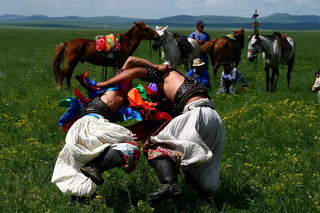
Mongolian Ethnic Minority
Having a population of 5.82 million, the Mongolians live mostly in the Inner Mongolia Autonomous Region, with the rest residing in Liaoning, Jilin, Heilongjiang, Xinjiang, Qinghai, Gansu, Ningxia, Hebei, Henan, Sichuan, Yunnan and Beijing. Having their own spoken and written language, which belongs to the Mongolian group of the Altaic language family, the Mongolians use three dialects: Inner Mongolian, Barag-Buryat and Uirad. The Mongolian script was created in the early 13th century on the basis of the script of Huihu or ancient Uygur, which was revised and developed a century later into the form used to this day.
The Mongolians have kept their nomadic living style for hundreds of years. "Mongolian" originally was the name of one of the Mongolian tribes roaming along the Erguna River. At the beginning of the 13th century, a Mongolian tribe headed by Genghis Khan unified all the Mongolian tribes, giving birth to a new people -- the Mongolian ethnic minority. In 1206, he was elected the Great Khan of all Mongols with the title of Genghis Khan. Kublai Khan, the grandson of Genghis Khan founded the Yuan Dynasty (1206-1368) in 1272, and subdued the Southern Song (1127-1279) in 1279, bringing the whole of China under his centralized rule.
Customs and habits
Mongolians grow up on horsebacks and horses thus play an important part in their life. Every Mongolian loves to prove his worth by showing good horsemanship and archery as well as wrestling. "Nadam," meaning games in Mongolian, is the name of a traditional Mongolian fair, which is held in July and August each year. At the fair, people wearing their holiday best, participate in horse racing, archery, singing, dancing, chess playing and wrestling.
The life of the Mongolians is unique. Those in the pastoral areas wear fur coats lined with satin or cloth or nothing at all in winter and loose, long-sleeved cotton robes in summer. Mongolian costume is generally red, yellow or dark blue in color. A red or green waistband, flint steel, snuffbox and knife in an ornate sheath for cutting meat are accessories common to all men and women. Knee-high felt boots are a type of common footwear. Mongolians, men and women, wear cone-shaped hats in winter; they also like to wear silk or cloth turbans. Girls wear their hair parted in the middle, embellished with two large beads and agate, coral and green jade ornaments.
In pastoral areas, beef, mutton and dairy products are the staple food, while in the farming areas, people like to eat grain. Tea is indispensable. Dried cow dung is a common cooking fuel. Mongolian herdsmen used to live in felt yurts, which were usually seven to eight feet high and ten feet in diameter. With an opening in the top of the umbrella-shaped roof, they give ideal ventilation and good protection against wind and cold. After the mid-20th century, as more and more herdsmen ended their nomadic life and settled down, they began to build yurt-like houses of mud and wood and one-storied houses, each with two or three rooms like those in other parts of the country. The Mongolians are warm-hearted and straightforward. They welcome strangers traveling on the grasslands to stay for the night in their yurts and treat them to tea with milk, mutton and milk wine. Upon leaving, the guests will invariably be given a warm send-off by the hosts.
Mongolian Religion
The Mongolians believe in Lamaism. They are hospitable, zealous and frank. They always offer the breast and tail of the sheep or lamb as a special treat to distinguished guests, and drink wine and sing songs to entertain guests while they eat. Presenting Hada, a strip of white silk, to the guest is the highest etiquette of the Mongolians.
Mongolian Festival
On the grassland, the Nadam Festival is held each August by the Mongolians to celebrate their good harvest, lasting five to seven days. Contests such as archery on horseback, wrestling, horse racing and other traditional activities are held. The Bai Festival is the Mongolian New Year.
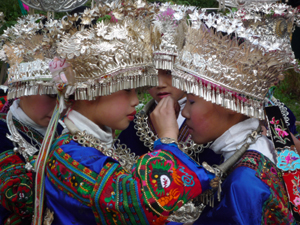
Miao Ethnic Minority
With a population of 8.9 million, the Miao people form one of the largest ethnic minorities in southwest China. They are mainly distributed across Guizhou, Yunnan, Hunan and Sichuan provinces and Guangxi Zhuang Autonomous Region, and a small number live on Hainan Island in Guangdong Province and in southwest Hubei Province. Most of them live in tightly-knit communities, with a few living in areas inhabited by several other ethnic groups. On the Yunnan-Guizhou Plateau and in some remote mountainous areas, Miao villages are comprised of a few families, and are scattered on mountain slopes and plains with easy access to transport links.
Much of the Miao area is hilly or mountainous, and is drained by several big rivers. The weather is mild with a generous rainfall, and the area is rich in natural resources. Major crops include paddy rice, maize, potatoes, Chinese sorghum, beans, rape, peanuts, tobacco, ramie, sugar cane, cotton, oil-tea camellia and tung tree. Hainan Island is abundant in tropical fruits.
Language
The Miao language belongs to the Miao-Yao Austronesian of the Chinese-Tibetan Phylum. It has three main dialects in China -- one based in west Hunan, one in east Guizhou and the other in Sichuan, Yunnan and part of Guizhou. The Miao people used to have their own characters which have long lost. After 1956, the Miao people invented a kind of phonetics characters. Due to their centuries of contacts with the Hans, many Miaos can also speak Chinese.
History
As early as the Qin and Han dynasties 2,000 years ago, the ancestors of the Miao people lived in the western part of present-day Hunan and the eastern part of present-day Guizhou. They were referred to as the Miaos in Chinese documents of the Tang and Song period (AD618-1279). In the third century AD, the ancestors of the Miaos went west to present-day northwest Guizhou and south Sichuan along the Wujiang River. In the fifth century, some Miao groups moved to east Sichuan and west Guizhou. In the ninth century, some were taken to Yunnan as captives. In the 16th century, some Miaos settled on Hainan Island. As a result of these large-scale migrations over many centuries the Miaos became widely dispersed.
Such a wide distribution and the influence of different environments have resulted in marked differences in dialect, names and clothes. Because of the different costumes, the miaos can be divided into Long Skirt Miao, Short Skirt Miao, Red Miao, Black Miao, etc.
Customs & culture
The Miaos are engaged in agriculture, with hunting as their sideline. Major crops include paddy rice, maize, rape, ramie, oil-tea camellia and tung tree, etc. The weather is mild with a generous rainfall, and the area is rich in precious medical herbs, such as Tian Qi, Gastrodia elata, etc. The Miaos have created a variety of colorful arts and crafts, including cross-stitch work, embroidery, weaving, batik, and paper-cut. Their batik technique dates back to 1,000 years ago. A pattern is first drawn on white cloth with a knife dipped in hot wax. Then the cloth is boiled in dye. The wax melts to leave a white pattern on a blue background. In recent years, improved technology has made it possible to print more colorful designs, and many Miao handicrafts are now exported. The Miaos are fond of singing and dancing, especially famous for their love songs and wine songs. Lusheng is their favorite musical instrument. In addition, flutes, copper drum, mouth organs,Xiao(a vertical bamboo flute) and Suona horn are also very popular. The Miao people used to believe in Animism and worship their ancestors or dragons. Now some of them believe in the Catholicism or Christianity.
Festival
The Miaos have the New Year Festival, the Flower Mountain Festival (May 5th), the Tasting New Rice Festival (between June and July), and the Tea Picking Festivals, etc.
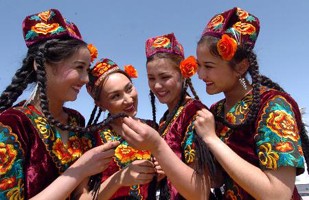
Uygur Ethnic Minority
Almost all the Uygurs are found in Xinjiang Uygur Autonomous Region which covers more than 1,709,400 square kilometers or approximately one sixth of China's total landmass, and is by far the biggest of the country's regions and provinces. It occupies much of the sparsely-populated northwest. Besides the Uygur ethnic group, Han, Kazak, Hui, Mongolian, Kirgiz, Tajik, Xibe, Ozbek, Manchu, Daur, Tatar and Russian people also live in Xinjiang. The Uygurs is the largest ethnic group in Xinjiang. They believe in Islam.
Language
The Uygur ethnic minority has its own language and alphabet, which belongs to the Turki Austronesian of Altai Phylum. They have two written languages, one is based on Arabian letters, and the other based on Latin letters, the latter of which was created after the founding of the PRC.
History
In their language, "Uygur" means "unity" or "alliance". The origin of the ethnic minority can be traced back to the Dingling nomads in northern and northwestern China and in areas south of Lake Baikal and between the Irtish River and Lake Balkhash in the third century BC. The Dingling were later called the Tiele, Tieli, or Chile. They established the Huihe Khanate in the 7th century. These ancient Uygur people were finally conquered by Turkic Kirghiz in the mid-ninth century. The majority of the Uygurs moved to the Western Region (present-day Xinjiang area). Some went to the Tufan principality in western Gansu Province. They intermarried with people in southern Xinjiang and Tibetan, the Hans, Turkic nomads, Qidan (Khitan) and Mongol tribes, and evolved into the group now known as the Uygurs. The Xinjiang Uygur Autonomous Region was formally established on October 1, 1955.
Agriculture
Mainly involved in agriculture, the Uygurs are also skilled in growing cotton, breeding silkworms, and spinning and weaving. The largest grape base of China is located in the Turpan Basin.
Customs & culture
The Uygur culture has a long and rich tradition. Many folk tales, parables, comedies, poems and proverbs praise the courage, wisdom and kindness of the ordinary people, while satirizing the greed, cruelty and foolishness of the exploiting classes. For instance,The Tales of Afandicontains stinging satire about the Bayis and Imams who bully the people. The Uygurs are excellent at dancing; the12 Mukams(opera) is an epic comprising more than 340 classic songs and folk dances. The Uygur dances, such as the "Bowls-on-Head Dance," "Drum Dance," "Iron Ring Dance" and "Puta Dance," feature light, graceful and quick-swinging choreography movements. The "Sainaim Dance" is the most popular, while the "Duolang Dance," sometimes referred to as a flower of Uygur folk culture, brims over with vitality. It depicts the hunting activities of the ancient people of Markit. The movements portray strength, wildness and enthusiasm. The "Nazilkum," popular in Turpan, Shanshan and Hami, fully reflects the Uygurs' optimism and gift for humor. The Uygur musical instruments include the Dutar, Rawap and Dap. The first two are instruments with a clear and crisp tone for solo and orchestral performances. Dap is a sheepskin tambourine with many small iron rings attached to the rim; it is used to accompany dancing.
Festival
The Uygurs are believers of the Islamic faith. The Corban Festival, the Noroz Festival, the Kaizhai Festival and the Nuolu Festival are the most important festivals to the Uygur people.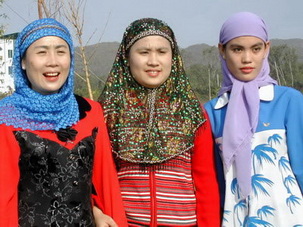
Hui Ethnic Minority
With a sizable population of over 9.81 million, the Hui ethnic group is one of China's largest ethnic minorities. People of Hui origin can be found in most of the counties and cities throughout the country, especially in the Ningxia Hui Autonomous Region and Gansu, Qinghai, Henan, Hebei, Shandong and Yunnan provinces and the Xinjiang Uygur Autonomous Region.
Language
The Hui people took Chinese as their common language. During their long history, the Hui people, aided by the Han people, accumulated great wealth. Their development and progress have been facilitated, however, by adopting the Han language and living with the Hans. Some of the Hui people are good at Arabic and Farsi.
History
Its origin can be trace back to the middle of the 7th century, when Islamic Arabs and Persians came to China to trade and later some became permanent residents of such cities like Guangzhou, Quanzhou, Hangzhou, Yangzhou and Chang'an (today's Xi'an). These people, referred to as "fanke" (guests from outlying regions), built mosques and public cemeteries for themselves. Some married and had children who came to be known as "tusheng fanke", meaning "native-born guests from outlying regions". These people later became part of the Hui ethnic minority. In the early years of the 13th century countless Islamite from Middle Asia, Persia and Arabia migrated voluntarily or compulsorily into China. As artisans, tradesmen, scholars, officials and religious leaders, they spread to many parts of the country and settled down mainly to stockbreeding. It was during the Ming Dynasty (1368-1644) that the Huis began to emerge as an ethnic minority. The Huis of today are therefore an ethnic minority that finds its origins mainly with the above-mentioned two categories, which in the course of development took in people from a number of other ethnic minorities including the Hans, Mongolians and Uygurs. It is generally acknowledged that Hui culture began mainly during the Yuan Dynasty.
Agriculture
The Hui people are mainly involved in agriculture; they also keep livestock, produce and trade handicrafts and food as well. Traditional items of trade are jewelry, jade and bullion.
Customs
The Islamic religion had a deep influence on the life style of the Hui people. The mosque is also a symbol of Hui architecture. According to the Hui's dietary rules, the meat of pig, dog, horse, donkey, mule as well as all birds and beasts of prey is not allowed. They are also prohibited from eating the blood of any animal, and from eating any living that dies naturally. Alcoholic drink is strictly forbidden. These taboos originated in the Koran of the Moslems. The Huis are very particular about sanitation and hygiene. Likewise, before attending religious services, they have to observe either a "minor cleaning," i.e. washing their face, mouth, nose, hands and feet, or a "major cleaning", which requires a thorough bath of the whole body.
Festival
The main festivals of the Hui ethnic minority are the Kaizhai Festival, Corban Festival and Almsgiving Festival.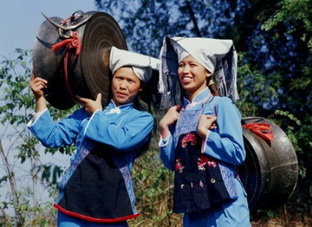
Zhuang Ethnic Minority
The Zhuang ethnic minority is China's largest minority group. Its population of about 16.18 million approaches that of Australia. Most of the Zhuangs live in southwest China's Guangxi Zhuang Autonomous Region, which is nearly the size of New Zealand. The rest have settled in Yunnan, Guangdong, Guizhou and Hunan provinces. While most Zhuang communities concentrate in a compact area in Guangxi, the others are scattered over places shared by other ethnic groups such as Han, Yao, Miao, Dong, Mulao, Maonan and Shui. Lying in Guangxi's mountainous regions, the Zhuang area is high in the northwest, undulating in the middle and low in the southeast. Limestone is widely distributed in the area, which is known round the world for its karst topography. Many rocky peaks rise straight up from the ground, and the peaks hide numerous fascinating grottoes and subterranean rivers. Guilin, a tourist attraction in Guangxi, is an excellent example of such landscape. As the saying goes: "The landscape at Guilin is the best on earth; and the landscape at Yangshuo is the best in Guilin." Wuming, Jingxi and Lingyun counties are also known for their scenic splendors.
Language
The Zhuang ethnic minority has its own language, which belongs to the Zhuang-Dai branch of Zhuang-Dong Austronesian, part of the Chinese-Tibetan Phylum. Ancient Zhuang characters appeared in the Southern Song Dynasty (1127-1279), but never got popularized. In 1955 the central government helped them create a writing system based on the Latin alphabet. Still the Chinese language is commonly used among the Zhuangs.
History
Tens of thousand years ago, ancestors of the Zhuang settled down in southern China. During the Spring and Autumn Period (770-221BC), they were one branch of the Baiyue people. The Zhuang areas first came under the administration of China's central authority 2,000 years ago. In 221 BC, the first emperor of the Qin Dynasty (221-206BC), China's first feudal emperor to unify the country, conquered the area and established three prefectures there. "Zhuang" was one of the names the ancestors of this ethnic minority gave to themselves. The term was first recorded some 1,000 years ago, in the Song Dynasty. The Zhuangs used to call themselves by at least a dozen other names, too. In 1958, the Guangxi Zhuang Autonomous Region was set up and in 1964 the group was proved by the State as the Zhuang ethnic minority.
Handicrafts
The Zhuangs are mainly engaged in agriculture, with paddy and corn as their main crops. San Qi and Hui Oil are the most famous special local products. Zhuang brocade, famous both at home and abroad, is a splendid handicraft which originated in the Tang Dynasty (618-907). Woven in beautiful designs with natural cotton warp and dyed velour weft, the brocade is excellent for making quilt covers, table-clothes, braces, aprons and handbags.
Customs & culture
Legends, fairy tales, stories and ballads frame the folk literature of the Zhuangs who have also been reputed for their singing. Sweet songs can be heard wherever you go in the Zhuang area. Extemporaneous melodies and lyrics and clever use of metaphors, riddles and cross-examinations add charm to their songs.
The Zhuangs are polytheists, worshipping among other things like giant rocks, old trees, high mountains, land, dragons, snakes, birds and ancestors. Taoism and Buddhism have also had a deep influence on the Zhuangs since the Tang Dynasty (618-907). Foreign missionaries of Christianity and Catholicism came to the area in the 19th and early 20th centuries, but their influence was limited to cities and towns.
Festival
While sharing many festivals with the Hans, such as the Spring Festival, the Mid-autumn Festival, the Dragon Boat Festival, etc., the Zhuangs have their own traditional festivals: the Devil Festival, the Cattle Soul Festival, the Feasting Festival, and the Singing Festival (on the third of the third lunar month), among which the Singing Festival is the most famous.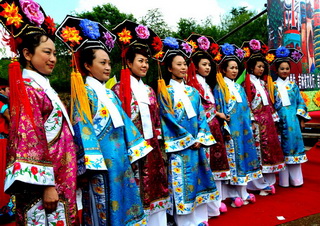
Manchu Ethnic Minority
The Manchu, with a population of 10.68 million, are mainly distributed in Liaoning, Jilin and Heilongjiang provinces, of which Liaoning has the most Manchus. A small number of the Manchus scatter in Inner Mongolia Autonomous Region, Xinjiang Uygur Autonomous Region, and Hebei, Shangdong provinces as well as in Chengdu, Xi'an, Guangzhou and other cities.
Language
Manchu has its own language and letters, which belong to the Manchu-Tungusic Austronesian of the Altaic Phylum. Manchu letters were created in the 16th century on the base of Mongolian letters. With more and more Manchus settling in the Central Plains since the Qing Dynasty (1644-1911), the economic and cultural exchange between the Hans and Manchus became more and more frequent and the Manchus gradually adopted the Han language.
History
Manchu history can be traced back to the Nuzhen people who lived 2,000 years ago. They were the earliest ancestors of the Manchu. In the Liao (916-1125), Song (960-1279), Yuan (1271-1368) and Ming (1368-1644) dynasties, they were called "Nuzhen". At the end of the 16th century, Nurhachi unified the tribes of Nuzhen and a new ethnic group -- Manchu -- came into being. With the founding of the Qing Dynasty in 1644, the Manchu reached its golden age. After the 1911 Revolution, this ethnic minority was named the Manchu ethnic minority.
Handicrafts
Like the Han people, most Manchus are engaged in agriculture-related jobs. They also raise tussah silkworms. Most of the Manchu people in cities, who are better educated, are engaged in traditional and modern industries.
Costumes
The traditional costumes of a Manchu man are a narrow-cuffed short jacket over a long gown with a belt at the waist to facilitate horse-riding and hunting. Manchu women used to wear loose-bodied Cheongsams and embroidered shoes. In the past, Manchu men wore their hair long. They braided their hair and let the braids droop behind their heads. During the Qing Dynasty (1644-1911) the queue became the standard fashion throughout China, eventually becoming a political symbol of the dynasty. Women coiled their hair on top of their heads and wore earrings and headgear. Following the Manchus' southward migration, the common people came to wear the same kind of dress as their Han counterparts, while the Manchu Cheongsam was adopted by the Han women generally.
Religion & festival
Most Manchus believed in Shamanism in the past, thinking that there were many gods commanding the world. Now this belief has faded away. The Manchu and the Han basically share the same festivals and holidays such as the Spring Festival, the Duanwu Festival and the Mid-autumn Festival, although there are still some differences in terms of celebrating ceremonies. During festivals, the Manchus always hold various traditional sports activities, of which the most common sports are Pearl Ball and skating.
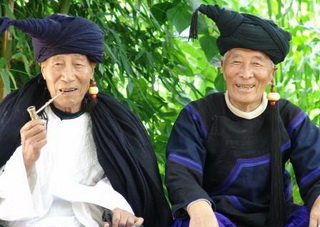
Yi Ethnic Minority
The Yi ethnic group, with a population of more than 7.76 million, is mainly distributed over the provinces of Sichuan, Yunnan and Guizhou, and the Guangxi Zhuang Autonomous Region. There are more than one million Yis in Sichuan Province, and most of them live in an area south of the Dadu River and along the Anning River. Traditionally, this area is subdivided into the Greater Liangshan Mountain area, which lies east of the Anning River and south of the Huangmao Dyke, and the Lesser Liangshan Mountain area, which covers the Jinsha River valley and the south bank of the Dadu River. There are over a million Yis in the Liangshan Yi Autonomous Prefecture, which holds the single largest Yi community in China. Yunnan Province has more than three million Yis, most of whom are concentrated in an area hemmed in by the Jinsha and Yuanjiang rivers, and the Ailao and Wuliang mountains. Huaping, Ninglang and Yongsheng in western Yunnan form what is known as the Yunnan Lesser Liangshan Mountain area. In Guizhou, more than half a million Yis live in compact communities in Anshun and Bijie. Several thousand Yis live in Longlin and Mubian counties in the Guangxi Zhuang Autonomous Region.
Most Yis are scattered in mountain areas, some in frigid mountain areas at high altitudes, and a small number live on flat land or in valleys. The altitudinal differences of the Yi areas directly affect their climate and precipitation. Their striking differences have given rise to the old saying that "the weather is different a few miles away" in the Yi area. This is the primary reason why the Yis in various areas are so different from one another in the ways they make a living.
Language
The Yi language belongs to the Tibeto-Burman Austronesian of the Chinese-Tibetan Phylum, and the Yis speak six dialects. Many Yis in Yunnan, Guizhou and Guangxi know the Han (standard Chinese or Mandarin) language. The Yis used to have a syllabic script called the old Yi language, which was formed in the 13th century. It is estimated that the extant old Yi script has about 10,000 words, of which 1,000 are words of everyday use. Since the old Yi language is not consistent in word form and pronunciation, it was reformed for use in books and newspapers in 1957.
History
The ancestors of the Yi ethnic minority can be traced back to the Qiang people living in northwest China. They later migrated south and joined the local southwest aboriginal and created a new group -- the Yi ethnic minority.
In the Eastern Han (25-220), Wei (220-265) and Jin (265-420) dynasties, inhabitants in these areas came to be known as "Yi". In the past, most Yis called themselves "Luoluo", although many different appellations existed. After liberation, following consultation with the ethnic minority, it agreed upon the official name of the Yi ethnic minority.
Customs & culture
Most Yi people are engaged in agriculture and a small percentage of them raise livestock. Their traditional fine arts include painting, sculpture, lacquer painting and embroidery, etc. The Yi culture has a long history. A number of works of history, literature and medicine as well as calendar written in the old Yi script are still seen in most Yi areas, which are of great significance. A famous poem called A Shimais one representative literary works of the Yis. In the story, a girl named A Shima fought for her free love and was killed by flood. A Shima turned into stone carving in legend, but her love story has spread all over China.Group dance is popular in Yi region. The participators stand in a circle, hands in hands, dancing accompanied by reed and other music instruments. Tiao Yueis a famous dance of the Yi people.
Religious faith & festival
The Yi people used to believe in many gods and worshiped ancestors. Some people who live with Han people also believe in Buddhism and Taoism, and few believe in Catholicism and Christianity.Yi people have many traditional festivals, of which the most important include the Torch Festival and the October New Year.
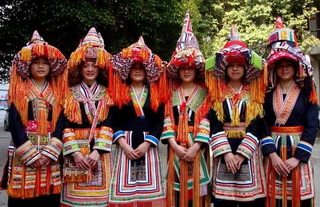
Yao Ethnic Minority
The Yaos, with a population of 2,637,421, live in mountain communities scattered over 130 counties in five south China provinces and one autonomous region. About 70 percent of them live in the Guangxi Zhuang Autonomous Region, the rest in Hunan, Yunnan, Guangdong, Guizhou and Jiangxi provinces. Historically, the Yaos have had at least 30 names based on their ways of production, lifestyles, dresses and adornments. The name "Yao" was officially adopted after the founding of the People's Republic in 1949.
Most Yaos live in beautiful, humid mountain valleys densely covered with pines, firs, Chinese firs, Chinese cinnamons, tung oil trees, bamboos and tea bushes. The thickly forested Jianghua Yao Autonomous County in Hunan is renowned as the "home of Chinese firs." The places inhabited by the Yaos also abound in indigo, edible funguses, bamboo shoots, sweet grass, mushrooms, honey, dye yam, jute and medical herbs. The forests are teeming with wild animals such as boars, bears, monkeys, muntjacs and masked civets. Rich as they are in natural resources, the Yao mountain areas are ideal for developing a diversified economy.
Language
The ethnic minority has its own language which belongs to the Yao Austronesian of Chinese-Tibetan Phylum. There are three local dialects that show considerable variations. As a result of close contacts with the Han and Zhuang people, many Yaos are also familiar with the Han and Zhuang languages. The Yao people have no written language of their own, so they mainly use written Chinese.
History
The Yao's ancestry can be traced back to the Wuling tribe near Changsha (Hunan Province) as well as the ancient Moyao tribe during the Qin and Han periods (221BC-220AD). It was during the Ming and Qing periods (1368-1911) that they gradually migrated to Hunan, Guizhou, Yunnan, Guangxi and other provinces. The Yaos call themselves Mian, Jinmen, Bunu, Lajia and Bingduoyou, etc. It is estimated that are about 300 Yao subgroups living in China, with differing traditional costumes and dialects. Therefore, the Yao ethnic minority has many names including Panyao, Shanziyao, Guoshanyao, Pindiyao and Baikuyao, etc., all of which has the same syllable Yao. After the founding of the PRC in 1949, the name Yao ethnic minority was officially adopted.
Customs & culture
Most Yao people are engaged in agriculture, and others are involved in forestry. They are especially skilled in embroidery, weaving and dyeing. The Yaos worshipped a plethora of gods, and their ancestors. Their belief in "Panhu", the dog spirit, revealed a vestige of totemism. During festivals, Yao communities hold lavish rites to offer sacrifices to their ancestors. Many Yaos think it taboo to eat meat of dog, glede, sow, cat and snake. A daily necessity of the Yaos is "oil tea". The tealeaves are fried in oil, then boiled into a thick, salty soup and mixed with puffed rice or soybeans. The oil tea serves to entertain the visitors on some occasions.
Festivals
Festivals take place one after another in the Yao communities, at a rate of about once a month. They share some festivals with the Han people, such as the Spring Festival, the Qingming Festival, the Dragon Boat Festival and the Mid-autumn Festival. In addition, the Yaos have their own festivals, which alter from place to place in the Yao region, for instance, the Land God Festival, the Danu Festival and the Shuagetang Festival. The "Danu" Festival, celebrated in the Yao Autonomous County of Duan in Guangxi, is said to commemorate ancient battles.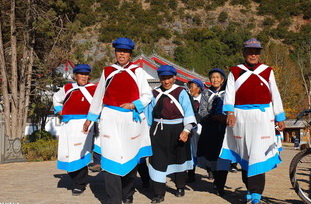
Naxi Ethnic Minority
The Naxi ethnic minority has a population of 308,839, most of whom live in concentrated communities in the Lijiang Naxi Autonomous County in Yunnan Province, the rest being scattered in Weixi, Zhongdian, Ninglang, Deqin, Yongsheng, Heqing, Jianchuan and Lanping counties in Yunnan, as well as Yanyuan, Yanbian and Muli counties in Sichuan Province. A small number live in Mangkang County of Tibet Autonomous Region. The Naxi areas, traversed by the Jinsha, Lancang and Yalong rivers, and the Yunling, Xueshan and Yulong mountain ranges, have a complicated terrain. There are cold mountainous areas, uplands, basins, rivers and valleys, averaging 2,700 meters above sea level. The climate varies from cold and temperate to subtropical. Rainfall is plentiful.
Language
The Naxi ethnic minority has its own language which belongs to the Yi branch of Tibeto-Burman Austronesian of the Chinese-Tibetan Phylum. The ancient Naxi people created pictographic characters called the "Dongba" script and a syllabic writing known as the "Geba" script. However, they were difficult to master, and in 1957 the government helped the Naxi design an alphabetic script. Due to close contact with the Han people over the past several hundred years, the Naxi people also use the oral and written Chinese to communicate.
History
According to historical documents, the forefathers of the Naxi people were closely related to a tribe called "Maoniu Yi" in the Han Dynasty (206BC-220AD), "Mosha Yi" in the Jin Dynasty (265-420) and "Moxie Yi" in the Tang Dynasty (618-907). The Naxis also had a number of other names. In 1278, the Yuan Dynasty established Lijiang Prefecture representing the imperial court in Yunnan Province. After the founding of the PRC in 1949, following consultation with the ethnic minority, it agreed upon the official name of Naxi ethnic minority.
Agriculture
Agriculture is the main occupation of the Naxi people, together with stockbreeding and handicraft industry. The banks of the Jinsha River are heavily forested, and Yulong Mountain is known at home and abroad as a "flora storehouse". The extensive dense forests contain Chinese fir, Korean pine, Yunnan pine and other valuable trees, as well as many varieties of herbs.
Customs & culture
Naxi literature is rich in form and content. The Dongba script created in the seventh century by the Naxi people is the only pictographic characters extant in the world. The Dongba Scripture, a religious work written in the pictographic script, describes the various aspects of life of the Naxi people during their long transition from slavery to feudalism. It is extremely important for the study of Naxi literature, history and religion.
Religion & festival
Most Naxi people were followers of the Dongba religion, which is a form of Shamanism. Lamaism, Buddhism, Taoism and Christianity only have limited access to the Lijiang area. The traditional festivals include the Farm-Tool Fair in January, the God of the Rain Festival in March, and the Mule and Horse Fair in July. There are also the Spring Festival, the Qingming Festival, the Dragon Boat Festival, the Mid-autumn Festival and the Torch Festival - all being the same as those of the Hans.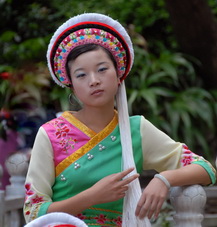
Bai Ethnic Minority
Of the 1,858,063 Bai people, 80 percent live in concentrated communities in the Dali Bai Autonomous Prefecture in Yunnan Province, southwest China. The rest are scattered in Xichang and Bijie in neighboring Sichuan and Guizhou provinces respectively. The Bais speak a language related to the Yi branch of the Tibetan-Myanmese group of the Chinese-Tibetan language family. The language contains a large number of Chinese words due to the Bais' long contact with the majority Chinese ethnic group - Han.
Situated on the Yunnan-Guizhou Plateau, the Bai area is crisscrossed with rivers, of which the major ones are the Lancang, the Nujiang and the Jinsha. The river valleys, dense forests and vast tracts of land form a beautiful landscape and provide an abundance of crops and fruits. The area around Lake Erhai in the autonomous prefecture is blessed with a mild climate and fertile land yielding two crops a year. Here, the main crops are rice, winter wheat, beans, millet, cotton, rape, sugar-cane and tobacco. The forests have valuable stocks of timber, herbs of medicinal value and rare animals. Mt. Diancang by Lake Erhai contains a rich deposit of the famous Yunnan marble, which is basically pure white with veins of red, light blue, green and milky yellow. It is treasured as building material as well as for carving.
Culture and folklore
Over the centuries, the Bais have created a science and culture of their own. Agriculture was dominant in the Erhai area as early as the Neolithic Age. People then knew how to dig ditches for irrigation. During the Nanzhao regime, they began the cultivation of rice, wheat, broomcorn, millet and several other crops, and built the Cangshan water-conservancy project which could bring water to tens of thousands of hectares of land. To their credit are inventions and advances in meteorology, astronomy, calendar, architecture, medical science, literature, music, dancing, carving and painting. Among the representative works of the Bai people are Transit Star Catalogue for Time Determination by the Ming Dynasty scholar Zhou Silian, Collection of Secret Prescriptions by Chen Dongtian and Tested Prescriptions by Li Xingwei. These classics recorded and summarized in detail the valuable experience of the Bai people in astronomy and medicine.
The superb architectural skill of the Bai people is represented by the three pagodas at the Chongsheng Temple in Dali. Built during the Tang Dynasty, the 16-storey main tower is 60 meters high and still stands erect after more than 1,000 years. It bears a resemblance to the Dayan Pagoda (Wild Goose) in Xi'an, an ancient Chinese capital city in today's Shaanxi Province. Figurines in the Shibaoshan Grottoes in Jianchuan County are lifelike, possessing both the common features of figure creation in China and the unique features of the Bai artists. The architectural group in the Jizushan Temple, with bow-shaped crossbeams, bracket-inserted columns, and gargoyles representing people, flowers and birds created with the open carving method, shows the excellent workmanship of the Bai people. The Bais also have high attainments in lacquerware.
They have created a wealth of literary works reflecting their life, work, and struggles against nature and oppression. The epic, Genesis, sings the praises of the communal life of Bai primitive society. Some poems by Bai poets have been included in the Complete Poems of Tang Dynasty. The History of the Bais, Anecdotes of Nanzhao and Kingdoms of Southwest China are among the best historical works written by Bai historians. They provide important data for the study of the history of the Erhai area. The Bai people are good singers and dancers. The "Lion Dance," created during the Nanzhao regime, was appreciated in the central plains during the Tang Dynasty. Bai opera, known as chuichui, is an art form combining folk music and dancing. It has also absorbed some of the characteristics of Han operas. The famous painting depicting the Resurgence of the Nanzhao was created in AD 899 by Bai painters Zhang Shun and Wang Fengzong. This masterpiece was stolen by foreign imperialists in 900 from Beijing.
Festival
The "March Fair," which falls between March 15 and 20 of the lunar calendar, is a grand festival of the Bais. It is celebrated every year at the foot of the Diancang Hill to the west of Dali city. It is a fair and an occasion for sporting contests and theatrical performances. People gather there to enjoy dances, horse racing and other games. June 25 is the "Torch Festival." On that day, torches are lit everywhere to usher in a bumper harvest and to bless the people with good health and fortune. Streamers bearing auspicious words are hung in doorways and at village entrances alongside the flaming torches. Villagers, holding aloft torches, walk around in the fields to drive insects away.
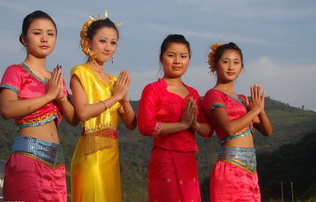
Dai Ethnic Minority
With a population of 1.16 million, the Dai ethnic group lives in the southern part of Yunnan Province, mainly in the Xishuangbanna region. The area is subtropical, with plentiful rainfall and fertile land. Local products include rice, sugar cane, coffee, hemp, rubber, camphor and a wide variety of fruits. Xishuangbanna is the home of China's famous Pu'er tea. The dense forests produce large amounts of teak, sandalwood and medicinal plants, and are home to wild animals including elephants, tigers and peacocks. The Dai language belongs to the Chinese-Tibetan language family and has three major dialects. It is written in an alphabetic script.
Customs and habits
The marriage of the Dais was characterized by intermarriage on strictly equal social and economic status. Polygamy was common among chieftains, who also humiliated the wives and daughters of peasants at will. The patriarchal m, onogamous nuclear family was the common form among peasants. Pre-marital social contact betw, een , young men and women was quite free, especially during festivals. It was common for the groom to move into the bride's home after the wedding.
The graveyards of aristocrats and poor people were strictly separated. When a monk or a Buddhist leader died, he was cremated and his ashes placed in a pottery urn to be buried behind a temple. Men wore collarless tight-sleeved short jackets, with the opening at the front or along the right side, and long baggy trousers. In winter they drape a blanket over their shoulders. They wore black or hite turbans. Tattooing was common. When a boy reached the age of 11 or 12, a tattoo artist was invited to tattoo his body and limbs with designs of animals, flowers, geometric patterns or the Dai written script. Traditionally, women wore tight-sleeved short dresses a, nd sarongs.
Rice is the staple food. The Dais in Dehong prefer dry rice, while those in Xishuangbanna like sticky rice. All love sour and hot flavors. In addition to beef, chicken and duck, they enjoy fish and shrimp. Cabbages, carrots, bamboo shoots and beans are among the popular vegetables. The Dais also love wine, liquor, and betel nuts. The villages of the Dais in Dehong and Xishuangbanna are found on the plains, near rivers or streams, and among clusters of bamboo. The buildings generally are built on stilts. Some of the houses are square, with two stories. The upper story serves as the living place, while the lower space, without walls, is used as a storehouse and for keeping livestock.
Dai festivals, closely related to religious activities, included the "Door-Closing" festival in mid-June by the lunar calendar, the "Door-Opening" festival in mid-September, and the "Water-Splashing" festival in spring. "Door-Closing" started three months of intensive religious activities. "Door-Opening" marked the beginning of normal life. "Water-Splashing," still held every year, is the most important festival, during which the Dais splash water on one another, and hold dragon boat races in the hope of chasing away all the illnesses and bad fortune of the past year and bringing about good weather and bumper harvests.
The Dais have a rich, colorful culture. They have their own calendar, which started in AD 638. There are books in Dai script for calculating solar and lunar eclipses. Dai historical documents carry a rich variety of literary works covering poetry, legends, stories, fables and children's tales. They love to sing and dance, accompanied by their native musical instruments. For a long time the Dais had grown rice as their main crop, and they had developed a rather complete, intensive farming system and gained rich experience in irrigation.
Religion
The religious beliefs of the Dai people were closely related to their economic development. Residents on the borders generally were followers of Hinayana, a sect of Buddhism, while retaining remnants of shamanism. There were many Buddhist temples in the countryside, and it was a common practice, especially in Xishuangbanna, to send young boys to the temples to learn to read and write and chant scriptures, as a form of schooling. Some of them became , monks, while most of them returned to secular life. While staying in the temple, the boys had to do all kinds of hard work, and the Dai people had to bear all the financial burden of the temples.
China Trip Planner | Travel Agents | About Us | Why Us | Contact Us | How to Pay | How to Book - Terms & Conditions | Site Map
Copyright © 2010 - 2030 All Rights Reserved.


 0086-28-85711328
0086-28-85711328 0086-28-85546015
0086-28-85546015



